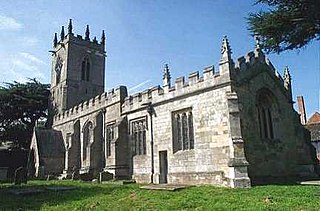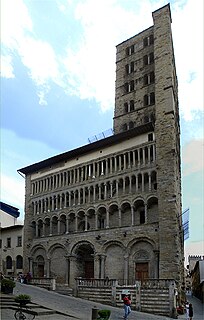
The Clock Tower of Bassano in Teverina is a Renaissance building in Viterbo, Italy, built to fortify the nearby church of Santa Maria dei Lumi's old bell tower by absorbing it in a tower. [1]

The Clock Tower of Bassano in Teverina is a Renaissance building in Viterbo, Italy, built to fortify the nearby church of Santa Maria dei Lumi's old bell tower by absorbing it in a tower. [1]
The accounts of some pastoral visits realized by the Diocese of Orte (the visitationes) show that the church of Santa Maria dei Lumi's bell tower was built between the 11th and 13th centuries at about 12 meters from the church's façade, in order to use it as a military tower too. However, this structure remained unused soon because another small bell tower was built on the roof of the church (to make the bells ropes handier).
The new tower was built all around the old bell tower between 1559 and 1571 by the Madruzzo family (feudatory of Bassano at that time), who wished to equip the hamlet of a more effective defense system as well as to use it as a symbol of family prestige.
The "two towers" characteristic remained totally unknown until the second half of the twentieth century, since the population was not aware of the existence of the bell tower inside the tower: the discovery was made during the work carried out to consolidate the tower's exterior. After informing the Superintendence, it was elaborated a project aimed at the coexistence of the two structures without demolishing the tower, allowing the simultaneous viewing of the internal bell tower, to which it was placed some filling material. The restoration began in 1976 and ended in 1984.
A few years ago, while a worker was walking on the pavement a few meters from the tower, he almost sank into a hole. After exploring it, it turned out to be a cistern of which, like the tower, people have been ignoring the existence. The cistern is about 10 meters deep and has a diameter of 2 meters, but it has not been fully explored. At the top, it is covered with bricks. By excavating the soil, they found shards, pieces of plates, coins and other not properly identified objects.
The tower was built with blocks of peperino, its squared base measures 7x7 meters and it is 25 meters high. It is provided with a clock having a face made of eighteenth-century majolica. The bell tower in the inside has got a squared base and is 27 meters high; it is separated from the tower by a 70 cm wide gap and it is made of blocks of peperino up to at 11 meters, blocks in limestone up to 22 meters and then again blocks of peperino in the last few meters.
The four floors that make up the bell tower are characterized by a series of double lancet and triple lancet windows held up by small columns animated by anthropomorphic figures called telamons, columns decorated with floral patterns or twisted columns. Only at the top floor the windows have no decorations, columns are thin and their capitals are slender but smooth. The side facing the church (N-W) is the most decorated, while the S-W side is undecorated.

The Piazza dei Miracoli, formally known as Piazza del Duomo, is a walled 8.87-hectare area located in Pisa, Tuscany, Italy, recognized as an important centre of European medieval art and one of the finest architectural complexes in the world. Considered sacred by the Catholic Church, its owner, the square is dominated by four great religious edifices: the Pisa Cathedral, the Pisa Baptistry, the Campanile, and the Camposanto Monumentale. Partly paved and partly grassed, the Piazza dei Miracoli is also the site of the Ospedale Nuovo di Santo Spirito, which houses the Sinopias Museum and the Cathedral Museum.

Strasbourg Cathedral or the Cathedral of Our Lady of Strasbourg, also known as Strasbourg Minster, is a Catholic cathedral in Strasbourg, Alsace, France. Although considerable parts of it are still in Romanesque architecture, it is widely considered to be among the finest examples of Rayonnant Gothic architecture. Architect Erwin von Steinbach is credited for major contributions from 1277 to his death in 1318, and beyond through his son Johannes von Steinbach, and his grandson Gerlach von Steinbach, who succeeded him as chief architects. The Steinbachs's plans for the completion of the cathedral were not followed through by the chief architects who took over after them, and instead of the originally envisioned two spires, a single, octagonal tower with an elongated, octagonal crowning was built on the northern side of the west facade by master Ulrich von Ensingen and his successor, Johannes Hültz. The construction of the cathedral, which had started in the year 1015 and had been relaunched in 1190, was finished in 1439.

Atessa is an municipality in the province of Chieti, Abruzzo, south-eastern Italy. It is part of the Val di Sangro mountain community. It is the largest municipality in the province by extension and eighth by population.

Bassano in Teverina is a comune (municipality) in the Province of Viterbo in the Italian region Latium. It is inhabited by 1,332 people and is located about 90 kilometres (56 mi) north of Rome and about 20 kilometres (12 mi) northeast of Viterbo.

Santa Chiara is a religious complex in Naples, Italy, that includes the Church of Santa Chiara, a monastery, tombs and an archeological museum. The Basilica church of Santa Chiara faces Via Benedetto Croce, which is the easternmost leg of Via Spaccanapoli. The church facade of Santa Chiara is diagonally across from the church of Gesù Nuovo.

Santa Maria del Campo is a town and municipality in the Province of Burgos, Spain. The village is in the wine region known as Ribera del Arlanza, 22 km from Lerma.

Gothic architecture appeared in the prosperous independent city-states of Italy in the 12th century, at the same time as it appeared in Northern Europe. In fact, unlike in other regions of Europe, it didn’t replace Romanesque architecture, and Italian architects weren’t very influenced by it. However, each city developed its own particular variations of the style. Italian architects preferred to keep the traditional construction methods established in the previous centuries; architectural solutions and technical innovations of French Gothic were seldom used. Soaring height was less important than in Northern Europe. Brick rather than stone was the most common building material, and marble was widely used for decoration. In the 15th century, when the Gothic style dominated northern Europe and Italy, the north of the Italian Peninsula became the birthplace of Renaissance architecture.

Forum of Nerva is an ancient structure in Rome, Italy, chronologically the next to the last of the Imperial fora built.

Santa Maria del Pi is a 15th-century Gothic church in Barcelona, Catalonia, Spain. It is situated on the Plaça del Pi, in the Barri Gòtic district of the city.

St Martin of Tours' Church is a redundant Anglican church in the village of Saundby, Nottinghamshire, England. It is recorded in the National Heritage List for England as a designated Grade I listed building, and is under the care of the Churches Conservation Trust.
The Churches of the Vall de Boí are a set of nine Early Romanesque churches declared World Heritage Site by UNESCO and located in the Vall de Boí, in the Catalan comarca of Alta Ribagorça.

Santa Maria della Pieve is a church in Arezzo, Tuscany, central Italy.

Santa Maria in Calanca Castle is a tower in the municipality of Santa Maria in Calanca of the Canton of Graubünden in Switzerland. It, along with the neighboring Church of the Assumption of St. Mary, are both Swiss heritage sites of national significance.

The Nativity of St. John the Baptist Church, located at 2 Piața Libertății, Piatra Neamț, Romania, is a Romanian Orthodox church. Established by Prince Stephen the Great of Moldavia, it was built in 1497-1498 as part of his royal court in the town. The bell tower dates to the year after the church was completed, and is a symbol of the city. Both church and tower are well preserved examples of late 15th century Moldavian religious architecture.

Otranto Cathedral is a Roman Catholic cathedral in the Italian city of Otranto, dedicated to the Annunciation of the Virgin Mary. It is the archiepiscopal seat of the Archdiocese of Otranto. The cathedral was consecrated in 1088. It is 54 metres long by 25 metres wide and is built on 42 monolithic granite and marble columns from unknown quarries. Its plan is a three-aisled nave with an apsidal east end. On either side of the west façade are two lancet windows.

The Santa Maria Basilica, located in the municipality of Castelló d'Empúries in Girona, Catalonia, Spain, has for centuries been regarded as the Empordà Cathedral, although papal authorities have never granted it this rank. The building is the second largest in the Costa Brava, after the Girona Cathedral, and is big enough to justify cathedral status. It is a Gothic building begun in the thirteenth century that replaced a primitive Romanesque church from the tenth century. A few vestiges of this building remain, such as the first floors of the bell tower and the grant baptismal. It was completed in the fifteenth century, when the marble facade and the alabaster altarpiece of the main altar were finished. It contains a museum known as El Tresor, which contains a large collection of religious jewelry.

Santa Maria d'Amer is a Benedictine monastery in Amer, Selva, Catalonia, Spain.

Santa Maria dei Lumi is the former Roman Catholic parish church of Bassano in Teverina (VT); it is located next to the town's ancient hamlet entrance.

Pescina Cathedral is a Roman Catholic cathedral in Pescina, Abruzzo, Italy, dedicated to the Blessed Virgin Mary under the title of "Saint Mary of the Graces".

The Romanesque style of architecture was introduced in Portugal between the end of the 11th and the beginning of the 12th century. In general, Portuguese cathedrals have a heavy, fortress-like appearance, with crenellations and few decorative elements apart from portals and windows. Portuguese Romanesque cathedrals were later extensively modified, among others the Old Cathedral of Coimbra, although it only had some minor changes.
| Wikimedia Commons has media related to Torre dell'Orologio in Bassano in Teverina . |